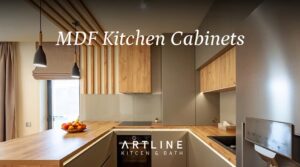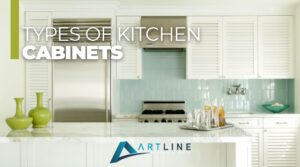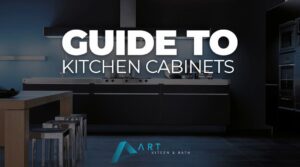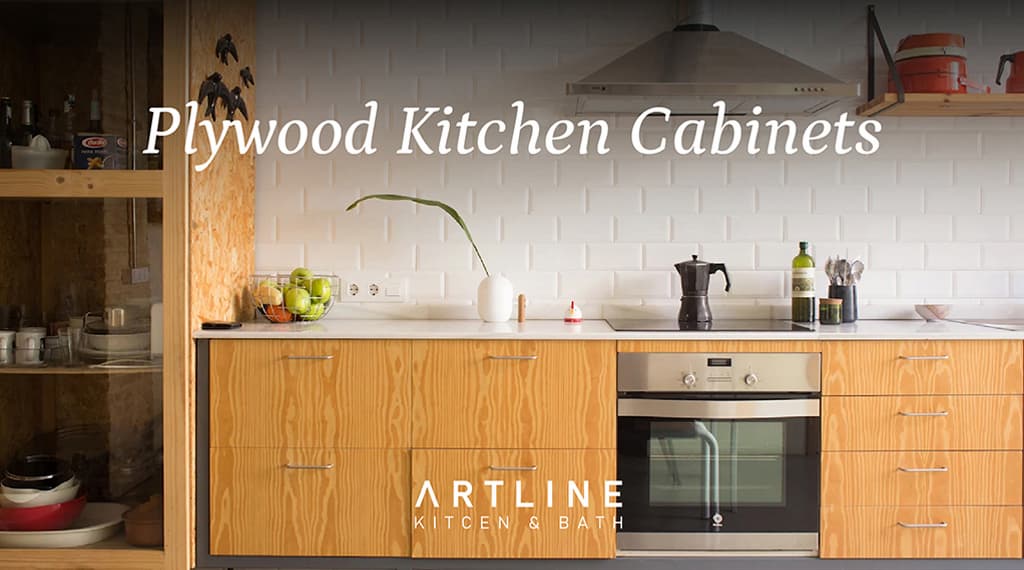Plywood kitchen cabinets offer a resilient and versatile option favored in many modern kitchens, combining exceptional durability with customizable aesthetics that fit a wide range of design preferences and withstand daily challenges like moisture and physical wear. Homes & Gardens notes that painted wood cabinet finishes, including plywood, will return in 2025.
Table of Contents
ToggleWhat is Plywood?
Plywood is engineered from multiple layers of thin wood veneers glued with grains oriented alternately, enhancing stability and strength. This construction method minimizes warping, a common issue in humid kitchen environments. Unlike MDF or particleboard, which tend to swell when exposed to water, plywood maintains its shape effectively under moisture stress, ensuring longevity in cabinet applications.
Plywood generally offers greater tensile strength and structural stability than particleboard, making it a better choice for high-traffic kitchen areas. Its cross-laminated construction resists warping, holds screws more securely, and performs better under load compared to the uniform but less dense structure of particleboard.
Why Choose Plywood Kitchen Cabinets?
Plywood cabinets excel in withstanding the typical demands of a kitchen setting. Key reasons include:
- Strength and Durability: Plywood resists bending and splitting, retaining stability over decades.
- Superior Moisture Resistance: It is significantly less susceptible to swelling than MDF or particleboard, critical for kitchen sinks and dishwashers.
- Hardware Compatibility: Screws and hinges anchor securely, reducing the risk of loose doors.
- Versatility: Suitable for cabinet boxes, shelving, and areas exposed to water.
- Lightweight Design: Easier to handle and install compared to solid wood, reducing labor costs.
These advantages contribute to plywood’s reputation as a dependable and aesthetically pleasing cabinet material.
Pros and Cons of Plywood Kitchen Cabinets
Pros:
- Longevity exceeding 15-20 years with proper maintenance
- Enhanced moisture resistance supports use near sinks and humid zones
- Customizable surface options, including paint, stains, and veneers
- Natural wood grain offers unique textures and character
- Lightweight yet robust, promoting easier installation
Cons:
- Higher initial cost compared to MDF or particleboard (approximately 20-40% more)
- Visible edges require finishing to avoid exposing the layered construction
- Variability in plywood grades necessitates careful selection
Plywood Grades and Thickness for Kitchen Cabinets
Common thicknesses range from 5/8-inch to 3/4-inch, offering ideal strength for cabinet boxes and shelves. Higher-grade plywood with a strong core resists delamination and significantly increases lifespan.
| Grade | Quality Description | Typical Use |
|---|---|---|
| A | Smooth, nearly flawless | Visible cabinet faces |
| B | Minor repairs, good surface | Semi-visible areas |
| C/D | Knots and patches present | Concealed parts like cabinet interiors |
Where Plywood is Used in Kitchen Cabinet Construction
Plywood’s strength and moisture resistance make it ideal for:
- Cabinet boxes, including sides, bottoms, and back panels
- Shelves and drawer bottoms where weight support is critical
- Sink base cabinets are frequently exposed to water
- Structural elements in kitchen islands or customized cabinetry
Best Finishes for Plywood Cabinets
- Paint: Provides a clean, protective layer that resists stains and moisture
- Stain: Enhances natural grain; species like walnut or cherry offer warm tones
- Clear Lacquer: Preserves color while creating a durable, water-resistant surface
- Veneers: Adds luxe appeal backed by plywood strength
- Edge Banding: Conceals plywood layers for a polished look
Finishes protect plywood and amplify kitchen aesthetics. Homes & Gardens indicates that stained wood cabinet finishes, including plywood, are making a comeback in 2025.
Plywood Cabinets and Moisture Performance
Plywood handles humidity and spills well, limiting damage through swelling and warping. Properly sealed edges and joints prevent mold growth and extend functional lifespan. A Financial Times article notes a rising preference among designers for stained or colored plywood over painted surfaces, especially in creative, sustainable projects.
Cost Breakdown of Plywood Kitchen Cabinets
1. By Construction Type
- Stock Plywood Cabinets
- Pre-manufactured in set sizes and styles
- Average cost: $100 – $250 per linear foot installed
- Pros: Affordable, quick delivery
- Cons: Limited customization
- Semi-Custom Plywood Cabinets
- Standard sizes with adjustable features (depth, finishes, accessories)
- Average cost: $200 – $450 per linear foot installed
- Pros: More style/finish options, better fit
- Cons: Higher price than stock, longer lead times
- Custom Plywood Cabinets
- Built to exact measurements, any style or finish
- Average cost: $400 – $800+ per linear foot installed
- Pros: Maximum design flexibility, high-quality craftsmanship
- Cons: Most expensive, longer production time
2. Factors That Influence Cost
- Plywood Grade
- Cabinet-grade plywood (A or B grade) is more expensive but smoother and stronger
- Lower grades (C or D) cost less but may have more imperfections
- Thickness
- Standard: ½-inch plywood (cheaper)
- Premium: ¾-inch plywood (stronger, more expensive)
- Finish
- Painted: $3 – $10 per sq. ft. extra
- Stained and sealed: $5 – $15 per sq. ft. extra
- Veneer overlay: $10 – $25 per sq. ft. extra
- Hardware & Accessories
- Soft-close hinges, pull-outs, and organizers can add $500 – $2,000 to the total kitchen cost
3. Average Total Kitchen Pricing
For a 10×10 kitchen (about 20–25 linear feet of cabinets):
- Stock plywood cabinets: $2,500 – $6,000
- Semi-custom plywood cabinets: $5,000 – $11,000
- Custom plywood cabinets: $9,000 – $20,000+
Cost-Saving Tips
- Use plywood for cabinet boxes but pair with MDF or solid wood doors to reduce cost
- Keep to standard sizes to avoid custom upcharges
- Select fewer specialty accessories and add them later if needed
Maintenance and Durability of Plywood Cabinets
Plywood cabinets require minimal upkeep, with cleaning limited to mild soap and cloth wiping. Minor scuffs are repairable via filler and touch-up finishes. When maintained well, plywood kitchen cabinets can consistently perform beyond 20 years, making them a cost-effective long-term investment. Additionally, regular inspection of cabinet joints and hardware, along with reapplying protective finishes when necessary, helps preserve their aesthetic appeal and structural integrity over time.
Plywood Cabinets in Different Kitchen Styles
Plywood’s adaptability fits many design aesthetics:
- Transitional: Couples warm wood tones with clean, modern lines
- Modern: Uses sleek painted or veneered surfaces for a minimalist look
- Rustic/Farmhouse: Accentuates natural grains and knots with natural stains
- Industrial: Exposed plywood edges mixed with metal hardware achieve an edgy vibe
These options allow customization to homeowners’ unique style preferences while maintaining functional benefits.
Plywood vs MDF vs Solid Wood in Kitchen Cabinetry
Plywood strikes a balance between MDF and solid wood:
- Plywood offers superior moisture resistance and strength, maintaining shape under stress
- MDF provides smooth painting surfaces, but is prone to swelling and water damage
- Solid Wood delivers natural beauty but is vulnerable to warping from humidity
Plywood generally holds up better than MDF in humid environments due to its stronger, more moisture-resistant construction. Its layered design helps prevent warping and maintain structural stability, making it a more reliable choice in wet or high-humidity kitchen zones.
Frequently Asked Questions (FAQs)
Are plywood cabinets better than MDF?
Yes, plywood is stronger, more water-resistant, and provides better longevity than MDF, particularly important in kitchen environments.
Do plywood cabinets resist water better?
Absolutely, plywood swells less and maintains structural stability near wet areas like sinks and dishwashers.
How long do plywood kitchen cabinets last?
With proper care, plywood cabinets can last 15 to 20 years or longer without significant deterioration.
Can you paint or stain plywood cabinets?
Yes, plywood readily accepts both paint and stains, offering a wide array of design possibilities.
Are plywood cabinets worth the cost?
While the initial investment is higher than MDF cabinets, plywood’s durability and hardware compatibility provide greater long-term value.
Are Plywood Cabinets Right for Your Kitchen?
Plywood cabinets are an excellent choice if you seek durability, moisture resistance, and style flexibility. They are especially appropriate for kitchens facing heavy use, rental properties requiring sturdy finishes, or home offices where solid wood may be cost-prohibitive.
ArtLine Kitchen & Bath ensures the selection of optimal plywood grades and finishes tailored to your budget and needs. With over 50 years of expertise, ArtLine offers free design consultations and convenient financing options, helping to make your kitchen vision a reality.
Upgrading your kitchen with plywood cabinets delivers a harmonious mix of enduring strength, elegant style, and cost-efficiency. Whether you’re remodeling your home, fitting out a small office, or equipping a tiny commercial space, plywood cabinets provide lasting value and beauty.
For personalized advice and expert craftsmanship, contact ArtLine Kitchen & Bath today.
Get your free consultation now and start planning the kitchen of your dreams with ArtLine’s expert team.

MDF Kitchen Cabinets: A Smart, Budget-Friendly Choice for Modern Kitchens
MDF kitchen cabinets represent one of the most practical solutions for homeowners seeking high-quality results without the premium price tag


Types of Kitchen Cabinets
Kitchen cabinets fall into three categories: customization level, layout, and style. Custom, semi-stock, and stock cabinets vary in flexibility and


Kitchen Cabinet Guide for Homeowners (2025)
Kitchen cabinets shape a kitchen’s look, feel, and function. From stock options starting around $100 per linear foot to fully

